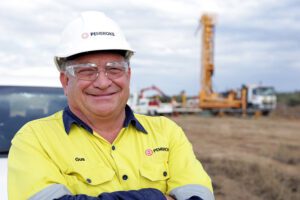While the entire mining industry is under strict cost cutting pressure, the recent shocking revelations of eight cases of Black Lung disease should make us reconsider the current dust prevention solutions, writes Dmitry Przhedetsky.
As the Australian mining industry is under strict cost-cutting pressure and companies are trying to reduce the operating costs and cut down on capital expenditures and upgrades, there is a high risk of overlooking the modern solutions to dust control. While the remaining scanty financial resources will be spent on upkeep of the existing equipment, very few people will be looking at upgrading their fleet with various add-ons, such as dust collectors.
This may be a crucial oversight, as not only the dust collectors offer a successful solution to the OHS issues, hence increase uptime, but also dust collectors retrofitted to the existing drills will increase the penetration rate and precision of drilling. The latter will contribute greatly to more consistent fragmentation, hence more savings down the cycle due to less oversize, better loading factor, less wear of buckets, trays and conveyors.
Unlike other dust removal solutions (e.g. water or foam), the operating cost of air-suction based dust collectors is substantially less, as they neither require water reticulation, nor extra supply of chemicals.
In underground environment, dust control is a fundamental issue and, regardless of the efficiency of the underground ventilation, should be a prerequisite. In open cut environment drill rigs have never been considered the major source of dust generation, yet they contribute to the overall volume of dust generated at the mine site. Again, efficient removal of dust and debris from blast holes will contribute to higher bailing velocity and better penetration rates, especially with multi-pass drilling.
In exploration drilling it is even more critical to keep the hole clean, as in absence of a decent dust collector to remove cuttings from the top of the hole there is increased likelihood of cuttings falling back into hole from the edge of the hole when the rig’s air is turned off (e.g. when adding rods). This will increase the chance of bogging rods because cuttings will get reground in the hole.
On top of it, in any application the advantage of dust collectors, apart from obvious OHS and environmental advantages, is that it keeps the rig cleaner which means it generally also gets better service and maintenance.
While the entire mining industry is under strict cost-cutting pressure, the recent shocking revelations of eight cases of Black Lung disease should make us reconsider the current dust prevention solutions. There are multiple advantages of active dust collectors – this is something that often gets overlooked, especially under strict cost cutting policy. However, dust collectors are not only a solution to the OHS and environmental problems, they also bring cost savings.
One of the manufacturers of industrial dust collectors, ILME Products, is located in Nyköping (approximately one hour drive from the Swedish capital Stockholm). A few years ago, the company moved into a newly erected building as it has outgrown the old one. ILMEG was founded in 1971 and has been growing ever since, currently being represented in 15 countries and exceeding the annual revenue of Euro 1.8 million dust collectors amount for nearly half of the revenue, with the other half generated from the Aftermarket; Precision Drilling Solutions and Asphalt Fume Solutions.
Having adopted the lean manufacturing strategy, ILMEG very much focused on two things – individual solutions for its clients and an advanced engineering design. Both concepts are driven by Magnus Eriksson, the president. Prior to taking the lead of ILMEG, Mr Eriksson has spent many years with another Swedish mining equipment manufacturer – Atlas Copco. He has inherited and brought to ILMEG their innovative approach, demand for quality and the ability to customise the equipment for clients.
One of the recent innovations of the company is a dust collector unit with self-cleaning filters.
The suction capacity, created by the unique design of the suction fan, is sufficient for any drilling application. The new self-cleaning filters, which are cleaned with reversed air during the drilling process, ensure that the full filter capacity is utilized at all times. Clean filters combined with a suction fan with high efficiency mean reduced power consumption and less noise compared to existing dust collectors.
The new filter design, using four filters instead of 24 filters in combination with high quality components result in high reliability of the system. The X-Series is specially designed for the extreme demand of mobile drilling equipment in the construction and mining industry.
The dust collectors would still remain the ILMEG number one product, as not only it perfectly works in mining, but also it works now at many construction sites.
A couple of years ago we saw on the French News that due to some construction in the neighbourhood, the invaluable paintings of the Musée de l’Orangerie got covered with construction dust. A few may argue, but there are some things which are even more precious than the Monet and Cézanne masterpieces, such as our lungs.
Not only we need to protect our national heritage, but also we need to make sure that the dust pollution is managed adequately at any mining and construction site.
It is even more so, if a construction site is adjacent to a fully operating hospital. In 2004, ILMEG commissioned its dust collector at the construction site for a new hospital in the Northern part of the Norwegian capital Oslo.
What made this project unique was that the new hospital was built wall-to-wall with the existing hospital. The existing hospital had been continuing all activities during the construction period. Understandably, the owner’s demand on dust and vibrations was extremely tough. Totally 330,000 bcm have been excavated whereof over 30 per cent was blasted rock. Much to the relief of the doctors (and certainly the patients), the newly developed centralised zero dust collector system reduced the dust levels to the absolute minimum during the construction. The dust collector was operated via radio signals and was electrically powered. Throughout the entire project the owner had been monitoring the dust inside the existing hospital. If the dust levels were too high they would have closed down the construction works immediately. This has not happened.
With the new focus on innovation it is obvious, that the first priority in mining will be given to productive equipment. Yet, it may be worth considering that not only the active dust collectors installed on all mobile equipment will reduce or eradicate serious and, often, irreversible health damage, such as Black Lung disease, but also will facilitate cost savings for the mining companies and contractors.
In underground environment, dust control is a fundamental issue and, regardless of the efficiency of the underground ventilation, should be a prerequisite.
PROFILE

Dmitry Przhedetsky
Director, Rock Cognition
Dmitry Przhedetsky (M Eng (Mining), FAusIMM) is the managing director of Rock Cognition Pty Ltd – an Australian socially responsible mining consultancy company. Rock Cognition has completed projects for various clients across the world, every time it has delivered ‘handmade’ mining consulting services to its clients. Of course, the ideas and their execution incorporate the latest technology and modern software.
Dmitry’s individual experience and knowledge base covers a broad range of minerals – from iron ore to salt mining, from underground coal to uranium mining, and from quarrying to tunnelling. He has been responsible for successful implementation of new mining methods and equipment, such as surface miners for iron ore and salt mining in Australia, 50-tonne underground truck and new generation of underground loaders in Australia, Mitsubishi TBM for soft rocks, and Teledyne breakers for gold mining in the former CIS.













Add Comment